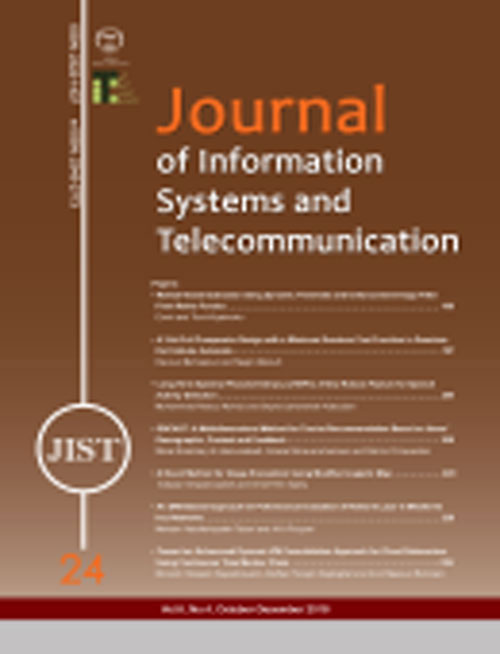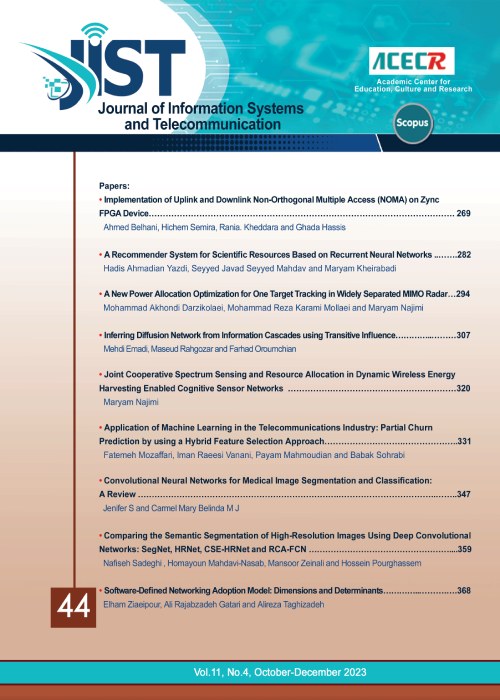فهرست مطالب

Journal of Information Systems and Telecommunication
Volume:7 Issue: 1, Jan-Mar 2019
- تاریخ انتشار: 1398/08/21
- تعداد عناوین: 7
-
-
Pages 1-11
A closed-form solution for target localization based on the realistic distance-dependent noises in illuminator of opportunity passive radar and the reduction method of the bias which exists in the two-stage weighted least squares (2SWLS) method is proposed. 2SWLS is a classic method for time-of-arrival (TOA) and frequency-of-arrival (FOA) localization problem and has a couple of improved solutions over the years. The 2SWLS and its improved solutions have great localization performances in their established location scenarios on the basis of two approximations that setting the noise to a constant and ignoring the high-order terms of TOA and FOA measurement noises. It is these two approximations that lead to a sub-optimal solution with bias. The bias of 2SWLS has a significant influence on the target localization in illuminator of opportunity passive radar that has lower measurement accuracy and higher noises than active radar. Therefore, this paper starts by taking into consideration of the realistic distance-dependent characteristics of TOA/-FOA noises and improving 2SWLS method. Then, the bias of the improved 2SWLS method is analyzed and bias-reduced solution based on weighted least squares (WLS) is developed. Numerical simulations demonstrate that, compared to the existing improved solutions of the 2SWLS, the proposed method effectively reduces the bias and achieves higher localization accuracy.
Keywords: TOA, FOA, target localization -
Pages 12-22
IEEE 802.11e is standardized to enhance real time multimedia applications’ quality of service (QoS). This standard introduces two access mechanisms called Enhanced distributed channel access (EDCA) and HCF Controlled Channel Access (HCCA) as well as four Access Categories (ACs) for different types of applications. Each AC has four adjustable parameters : Arbitrary Inter-Frame Space Number(AIFSN), minimum Size of Contention Window(CWmin), maximum size of Contention Window (CWmax), and TXOP_limit. A TXOP_limit (TXOP) is time interval, in which a wireless station can transmit a number of frames consecutively, without releasing the channel and any further contention with other wireless stations. TXOP improves network throughput as well as service differentiation. Proper TXOP adjustment can lead to better bandwidth utilization and QoS provisioning. This paper studies the determination of TXOP in EDCA mode of IEEE 802.11e using a game theory based approach called GDTXOP. Based on GDTXOP, each wireless node chooses its appropriate TXOP according to its queue length and media access delay. OPNET simulator simulated the proposed method and its accuracy is evaluated and verified. The results of the simulation indicate that tuning TXOP appropriately improves both channel utilization for all levels of traffic priority and fairness. This improvement does not impair the quality of high-priority traffics. The proposed approach improves channel utilization, while preserving fairness and efficiency in WLANs and minimizing selfishness behaviours of stations in a distributed environment. Simulation results show the proposed method improves fairness while not disrupting the quality of service.
Keywords: Transmission Opportunity (TXOP), Game Theory, WLAN -
Pages 23-33
Traditional methods of summarization were very costly and time-consuming. This led to the emergence of automatic methods for text summarization. Extractive summarization is an automatic method for generating summary by identifying the most important sentences of a text. In this paper, two innovative approaches are presented for summarizing the Persian texts. In these methods, using a combination of deep learning and statistical methods, we cluster the concepts of the text and, based on the importance of the concepts in each sentence, we derive the sentences that have the most conceptual burden. In the first unsupervised method, without using any hand-crafted features, we achieved state-of-the-art results on the Pasokh single-document corpus as compared to the best supervised Persian methods. In order to have a better understanding of the results, we have evaluated the human summaries generated by the contributing authors of the Pasokh corpus as a measure of the success rate of the proposed methods. In terms of recall, these have achieved favorable results. In the second method, by giving the coefficient of title effect and its increase, the average ROUGE-2 values increased to 0.4% on the Pasokh single-document corpus compared to the first method and the average ROUGE-1 values increased to 3% on the Khabir news corpus.
Keywords: Extractive Text Summarization, Unsupervised Learning, Language Independent Summarization -
Pages 35-49
Microarray data with small samples and thousands of genes makes a difficult challenge for researches. Using gene selection in microarray data helps to select the most relevant genes from original dataset with the purpose of reducing the dimensionality of the microarray data as well as increasing the prediction performance. In this paper, a new gene selection method is proposed based on community detection technique and ranking the best genes. Symmetric Uncertainty is used for selection of the best genes by calculation of similarity between two genes and between each gene and class label which leads to representation of search space as a graph, in the first step. Afterwards, the proposed graph is divided into several clusters using community detection algorithm and finally, after ranking the genes, the genes with maximum ranks are selected as the best genes. This approach is a supervised/unsupervised filter-based gene selection method that minimizes the redundancy between genes and maximizes the relevance of genes and class label. Performance of the proposed method is compared with thirteen well-known unsupervised/supervised gene selection approaches over six microarray datasets using four classifiers including SVM, DT, NB and k-NN. Results show the advantages of the proposed approach.
Keywords: Gene selection, Microarray data, Filter method -
Pages 50-64
One of the current challenges in providing high bitrate services in next generation mobile networks is limitation of available resources. The goal of proposing a self-optimization model is to maximize the network efficiency and increase the quality of services provided to femto-cell users, considering the limited resources in radio access networks. The basis for our proposed scheme is to introduce a self-optimization model based on neighbouring relations. Using this model, we can create the possibility of controlling resources and neighbouring parameters without the need of human manipulation and only based on the network’s intelligence. To increase the model efficiency, we applied the big data technique for analyzing data and increasing the accuracy of the decision-making process in a way that on the uplink, the sent data by users is to be analyzed in self-optimization engine. The experimental results show that despite the tremendous volume of the analyzed data – which is hundreds of times bigger than usual methods – it is possible to improve the KPIs, such as throughput, up to 30 percent by optimal resource allocation and reducing the signaling load. Also, the presence of feature extraction and parameter selection modules will reduce the response time of the self-optimization model up to 25 percent when the number of parameters is too high Moreover, numerical results indicate the superiority of using support vector machine (SVM) learning algorithm. It improves the accuracy level of decision making based on the rule-based expert system. Finally, uplink quality improvement and 15-percent increment of the coverage area under satisfied SINR conditions can be considered as outcome of the proposed scheme.
Keywords: Self-Optimization Networking, Big Data, Quality of service (QoS), Resource Allocation, Load Balancing -
Pages 65-73
In today’s world, most of companies are trying to survive in a competitive environment which has been increased in recent years. This competition has raised the customer power to select desired products and services among different suppliers and providers. So the importance of customer satisfaction and loyalty has been increased dramatically for companies and businesses. This is more important for distributor companies who deal with a lot of customers in a B2B market. Mobile-CRM has emerged new opportunities on customer satisfaction and can play as an efficient tool that will make great adjustments, savings and benefits for companies to provide better services for customers and have more retain customers. But implementing a Mobile-CRM system is a complicated large project that affects all aspects of an organization and needs a huge investment which increases the risk of failure. To avoid this risk, the assessing of company’s E-Readiness before starting main project is necessary. In this research we have used VERDICT model as a suitable model for assessing E-Readiness of a company willing to implement a Mobile-CRM system. A large distributor company is the case study of this research. The research is conducted based on a descriptive-survey method using questionnaire tools for extracting the experts' opinion and determining the company’s E-Readiness level.
Keywords: E-CRM, M-CRM, Mobile-CRM -
Pages 74-87
This paper proposes two algorithms for Voice Activity Detection (VAD) based on sparse representation in spectro-temporal domain. The first algorithm was made using two-dimensional STRF (Spectro-Temporal Response Field) space based on sparse representation. Dictionaries with different atomic sizes and two dictionary learning methods were investigated in this approach. This algorithm revealed good results at high SNRs (signal-to-noise ratio). The second algorithm, whose approach is more complicated, suggests a speech detector using the sparse representation in four-dimensional STRF space. Due to the large volume of STRF's four-dimensional space, this space was divided into cubes, with dictionaries made for each cube separately by NMF (non-negative matrix factorization) learning algorithm. Simulation results were presented to illustrate the effectiveness of our new VAD algorithms. The results revealed that the achieved performance was 90.11% and 91.75% under -5 dB SNR in white and car noise respectively, outperforming most of the state-of-the-art VAD algorithms.
Keywords: Speech Processing, Voice Activity Detector (VAD), Spectro-Temporal Domain Representation, Sparse Representation, NMF, K-SVD


